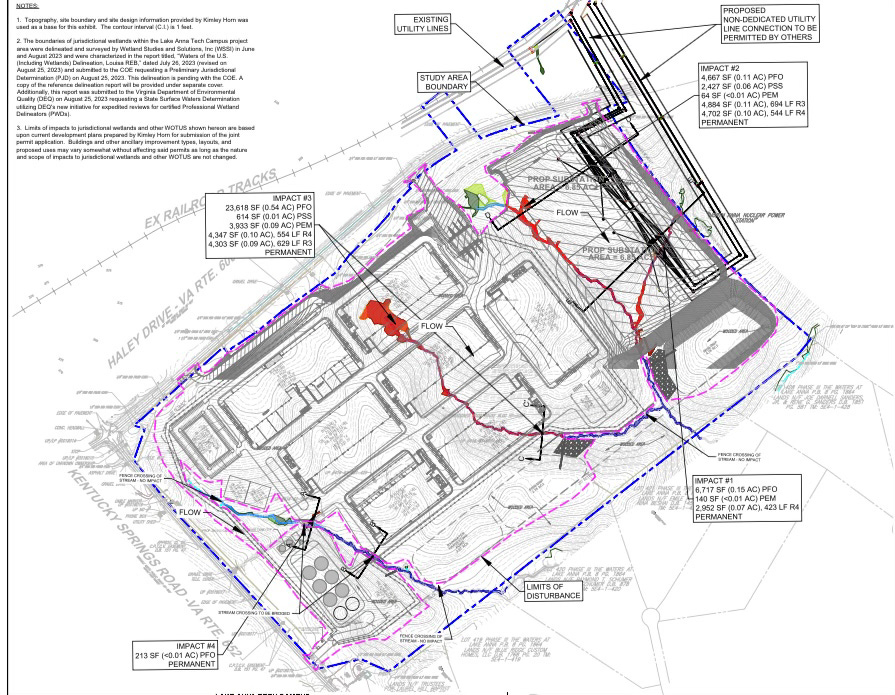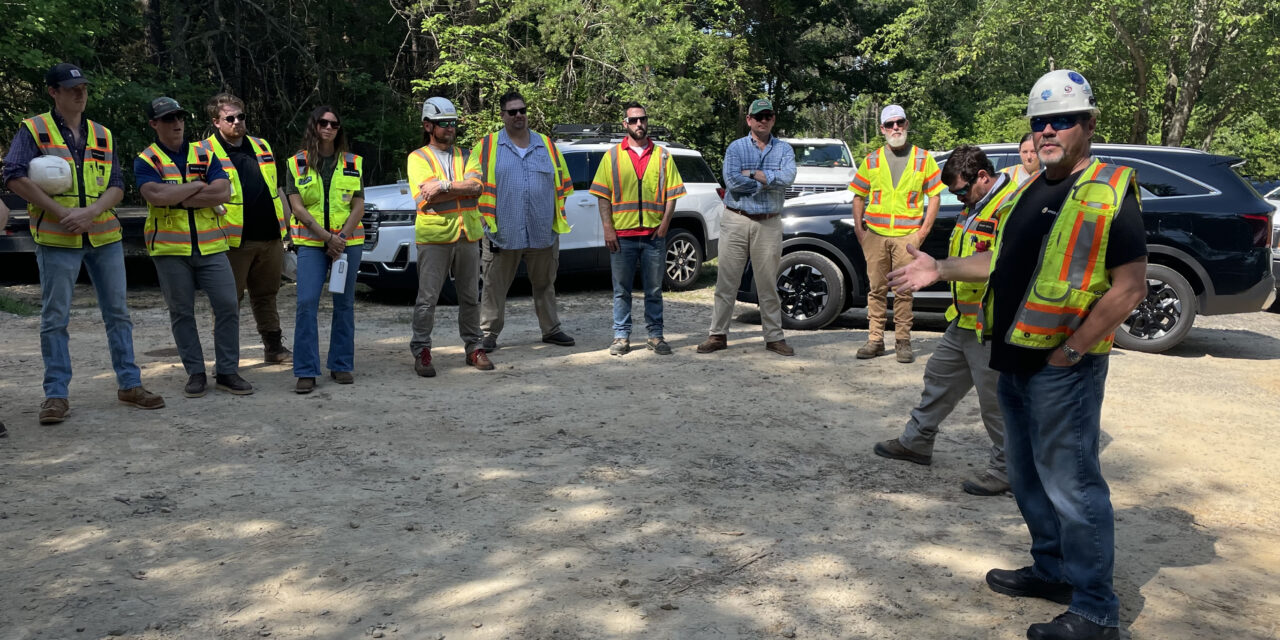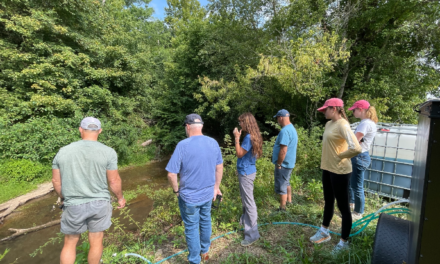By TAMMY PURCELL/Engage Louisa
A plan to build more than 1.7 million square feet of data centers adjacent to the North Anna Power Station is poised to take a significant step forward.
According to county officials, Amazon Web Services (AWS) is preparing to begin initial site work at the Lake Anna Technology Campus (LATC), a 153-acre site at the corner of Kentucky Springs Road (Route 652) and Haley Drive (Route 700) where the tech giant plans to develop seven standard data centers to support the burgeoning demand for cloud computing and other web-based services.
Contractors for AWS as well as county and state officials attended a pre-construction meeting at the campus on July 17. Louisa County Code Enforcement and Erosion and Sediment Control Administrator Kris Nelson told Engage Louisa after the meeting that Clark Construction, a national firm and the project’s general contractor, expects to break ground in the next two to four weeks.
Nelson said Clark is waiting for a greenlight from AWS before moving forward and the meeting was a “proactive” step to ensure work at the site starts smoothly.
Louisa County issued a land disturbance permit for the campus last week, the Virginia Department of Environmental Quality (DEQ) has issued an initial stormwater permit, and Nelson has signed off on the site’s erosion and sediment control plan.
With those approvals in hand, Clark is preparing to begin the “rough grading” phase. Rough grading includes the installation of erosion and sediment control and stormwater management features and initial grading for buildings and other infrastructure, according to Nelson.
Nelson said that motorists who travel Kentucky Springs Road will likely see an increase in traffic around the site in the coming weeks as contractors bring in large amounts of gravel and equipment. The gravel will be sourced from Cedar Mountain Stone Corporation in southern Culpeper County, likely increasing truck traffic on Route 522 between Rapidan and Wares Crossroads.
According to a permit issued by the Virginia Department of Transportation (VDOT) last week, the campus will include five construction entrances—four off Haley Drive and one off Kentucky Springs Road.
Nelson said the main construction entrance will be located off Haley Drive, and the county’s erosion and sediment control plan includes provisions to ensure that adjacent roadways are kept clean and free of debris.
Clark is a national construction firm with extensive experience building warehouses, medical centers and other large-scale projects. Nelson said the company recently served as general contractor for a 12-acre greenhouse in the Louisa County Industrial Air Park where Better Future Farms will produce hydroponic lettuce for wholesale customers.
While Clark will act as general contractor, other companies will participate throughout the construction process. Nelson said that Shirley Construction, a Northern Virginia-based firm, will handle the rough grading phase. Representatives from Shirley also attended the pre-construction meeting.
While AWS has secured some local and state permits, it has yet to clear all its permitting hurdles. The company has submitted a site plan for the project’s first phase to Louisa County’s Community Development Department. The plan is in a third round of staff review, per the county’s website.
The project’s first phase includes construction of a single one-story data center, an administration building, and ancillary infrastructure. The plan requires staff approval before AWS can apply for a building permit and begin construction, according to Senior Planner Tom Egeland.
AWS is also awaiting a permit from the Army Corps of Engineers (USACE), which is required because the project will permanently impact jurisdictional wetlands and other waters of the US (WOTUS).
A conceptual plan submitted as part of that application provides the most detailed look at AWS’s plans for the campus.
According to the plan, the company intends to build seven standard data centers on the property covering some 1.7 million square feet and providing a minimum of 420 megawatts (MW) of data center capacity “to serve the expanding demand for cloud-based computing.”
The campus is also expected to include an administration building, two smaller buildings, described in the application as “specialty data centers,” two substations capable of providing 300 MW of power each, stormwater basins, a rainwater harvesting pond and water and sewer infrastructure. One of the substations will be owned by Dominion Energy and the other by Rappahannock Electric Cooperative (REC), which provides electricity to the area.
Based on a public notice issued by the Corps in June, AWS’s application is working its way through the National Historic Preservation Act’s Section 106 process, which is required when a project is expected to impact significant cultural or historic resources.
The LATC includes the ruins of Laurel Hill, a circa 1800 home, and sits next to Laurel Hill Baptist Church, a historic African-American church founded in 1868 with an adjoining cemetery. Both sites are eligible for inclusion on the National Register of Historic Places.
As part of the Section 106 process, AWS and consulting parties, including the Virginia Department of Historic Resources, are negotiating a Memorandum of Agreement to minimize or mitigate adverse effects on historic properties, per the notice.
Nelson said that it’s his understanding that AWS is close to securing a USACE permit. He noted that any areas subject to the Army Corps’ jurisdiction will be protected as rough grading begins.
Engage Louisa reached out to USACE for an update on the permitting process. At publication time, no one from the agency had responded.
Economic Development Director Andy Wade, who played a key role in securing AWS’s initial commitment to develop data centers in Louisa County, said in an email last week that the campus’s first data center could be online by late 2025 or early 2026. He also said it could take four to five years for the project to reach full buildout, though he noted that was only a guess.
Nelson said that he isn’t sure how long the entire construction process will take, but he expects its traffic impact to come “in spurts” as contractors move in heavy equipment and materials while transitioning to different phases of the project.
Cuckoo District Supervisor Chris McCotter, who represents the area, also attended the pre-construction meeting. McCotter said in a telephone interview late last week that he has some concerns about how construction might affect Kentucky Springs Road and the surrounding community, but he believes the contractors will listen to neighbors and do what they can to minimize any negative impacts.
“I think that communication is incredibly important. From what I could tell the Clark Construction folks know how to communicate, and I think that they will be communicating and letting the community know what to expect,” McCotter said. “I stressed that we really need to understand what it is [they’re] wanting us to endure.”

Related data center and infrastructure development
The Lake Anna site is one of two data center campuses that AWS plans to develop in Louisa County over the next 15 years. The other—the North Creek Technology Campus (NCTC)—is slated for part of a 1444-acre assemblage south of Jefferson Highway (Route 33) and east of Mt. Airy Road (Route 644) near the Northeast Creek Reservoir.
Both campuses are in the county’s Technology Overlay District (TOD), a special zoning designation adopted by the board of supervisors in April 2023 with a goal of attracting lucrative tech sector development. The TOD allows data centers by-right, which means they don’t require a public approval process, and imposes a range of development standards on the use including buffer, setback and landscaping requirements and noise and height restrictions.
AWS has said it plans to start developing the LATC first. The company hasn’t formally applied for any local permits for the NCTC, according to Nelson, nor has it submitted a site plan to the county or publicly disclosed how many data centers it plans to build on the campus. Wade told Engage Louisa in March that AWS could build at least 17 data centers across both campuses.
AWS has submitted at least one significant and revealing document to the county related to the NCTC: a preliminary buffer and landscaping plan, which was publicly discussed at the Planning Commission’s November 9 meeting. The plan provides a glimpse of the potentially massive scale of the campus.
To support the NCTC’s intense demand for power, the plan includes 10 substations, covering 10 acres each, interspersed throughout the campus, and the extension of a 230 kilovolt (kV) transmission line that adjoins the campus’s northern edge.
Lee Brock, Rappahannock Electric Cooperative’s principal engineering manager for energy projects, told the commission that each substation is expected to have the capacity to provide 300 MW of power, meaning the company could supply as a much as 3 gigawatts (GW) of power to the site. For perspective, the twin Westinghouse reactors at North Anna produce about 1.8 GW of electricity, enough to power 450,000 homes.
AWS intends to develop about 816 acres of the NCTC while leaving 628 acres as open space. Of that, about 380 acres is expected to be donated to the county for potential use as a public park. The parkland winds through the campus with much of it hugging Northeast Creek, which runs through the eastern portion of the site.
The company plans to build a new public road system at its expense, which will provide access to both the data centers and parkland. One road extends south from Route 33 and snakes through the campus, connecting to Mt. Airy Road at the southern end of the site. AWS also plans to build an extension off White Walnut Road (Route 758) at the campus’s southern end, connecting it with the other proposed road just east of its intersection with Mt. Airy.
AWS plans to rely on the publicly owned Northeast Creek Reservoir to provide raw water to both the LATC and NCTC and potable water for the latter campus. Raw water will be used to cool the servers and networking equipment inside the facilities.
In a water service agreement inked with AWS in December, the county agreed to build a 11-mile raw water line from the reservoir to the LATC and related infrastructure to serve the site with a target completion date of January 2027. The county committed to build raw and potable water lines, measuring 2,000 feet each, to the NCTC, plus a 6,000-foot sewer force main down Route 33 to a new pump station at Thomas Jefferson Elementary School. That infrastructure is expected to be complete by July 2026.
The LATC will rely on groundwater to cool the data center included in the project’s first phase, according to Wade, then transition to the public system when the raw water line is complete.
At full build out, the campuses are expected to draw, on average, 630,000 gallons of water per day from the reservoir, Wade has said. Based on a recent capacity study, the reservoir has a safe yield capacity of 3.2 million gallons per day with current users, including the Town of Louisa, drawing about 300,000 gallons daily and 500,000 gallons per day at peak demand.
AWS has agreed to pay for all offsite infrastructure required for the sites, according to county officials and company representatives though some of that cost will be offset by state and local infrastructure grants. County officials have said that any local grant funding provided to the company would be drawn from tax revenue generated by the data centers.
Tax revenue from data centers can be tricky to predict because it’s, in part, based on how often pricey computer equipment is replaced. But Wade has said that one data center could generate just over $2 million in tax revenue annually over a 15-year timeframe. He’s also said that each data center could employ 20 to 25 people.
























